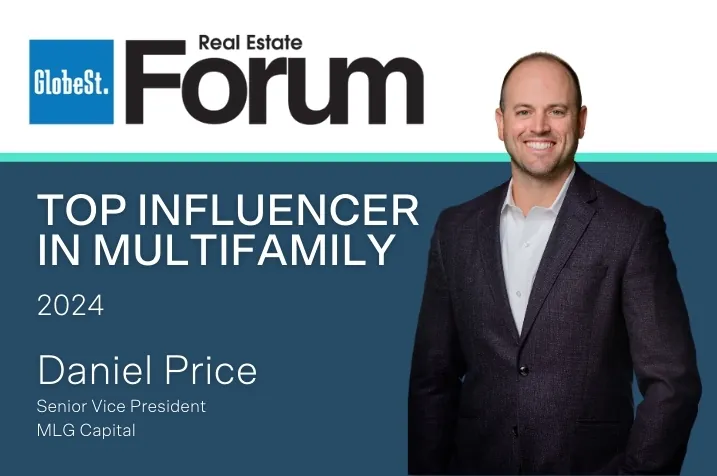Use “Income generated by retirement vehicles such as IRAs and 401ks are typically subject to UBTI when investing in passive, debt backed real estate, such as our offerings. We recognized this as a major deterrent for RIAs to expose their retirement fund clients to private real estate. As well, RIAs typically do not want to go through egregious process of filing multiple state tax returns for their retirement fund clients exposed to a real estate fund product. We created the MLG 1099 dividend fund as a way for RIAs to now expose their clients to the benefits of a diversified private real estate fund while targeting to avoiding UBTI and multistate filing,” said MLG Capital Assistant Vice President Mike Slinde.
MLG Capital (“MLG”) is accepting investments into MLG Private Fund IV LLC and the “MLG 1099 Dividend Fund IV,” a parallel fund that enables Registered Investment Advisors (RIAs) to gain access to private real estate via retirement vehicles while targeting to eliminate unrelated business taxable income (UBTI) and multi-state filings.
Each of the MLG Private Funds acquires, directly or indirectly, a geographically diverse portfolio of commercial real estate primarily consisting of (in order of preference) multifamily properties, industrial, retail, and office properties in several key U.S. markets. Since the inception of MLG Capital in 1987, the firm, and its associated entities, have had active, exited or pending investments of approximately 19.1 million square feet of total space across the United States, inclusive of more than 14,083 apartment units, with exited and estimated current value exceeding $1.765 billion*.
Since 1987, MLG Capital credits its impressive track record to its team. MLG Capital now boasts more than 294 employees across all business units, consisting of seven principals (with an average tenure of 23+ years), four attorneys, eight CPAs, engineers, land planners and many other highly trained real estate investment professionals. In addition to its internal staff, MLG Capital currently works with more than 1,800 real estate partners nationwide fueling a sourcing strategy yielding more than 50-55 real estate deals per month for consideration. With deep deal flow, the firm applies extreme due diligence and vetting, selecting to invest in 10-12 deals per year.
“Our 30-year operating history is rooted in absolute integrity and this shows in our clients’ results. We’re proud that our track record of favorable returns has earned us a strong reputation and following of hundreds of satisfied investors. Our experience is in real estate investment and management first, so when it comes to selecting properties, our clients know that there are trusted experts at the helm. Our successes are truly our clients’ successes,” said MLG Capital CEO & Principal Timothy J. Wallen.
“We target 12-16% net IRR returns to our investors from a combination of cash flow and appreciation over time and have consistently achieved these returns over our 31+ year history. We understand that our investors want a consistent return on their real estate investments without the hassle of management and we strive to operate as a family that each of our investors become part of as they invest with us. We’ve consistently proven our ability to achieve profits in various market cycles and economic conditions. Deal sourcing is key in finding opportunities, regardless of cycle, and we’re keenly focused on generating a deep and vast deal flow network across the country” said Wallen.
This article is for informational purposes only and is qualified in its entirety by reference to the Confidential Private Placement Memorandum (as modified or supplemented from time to time, the “Memorandum”) of MLG Private Fund IV LLC (the “Main Fund”) and MLG 1099 Dividend Fund IV LLC (the “Parallel Fund,” and together with the Main Fund, the “Fund”), the limited liability company agreements (the “LLCAs”) of the Main Fund and the Parallel Fund, each as may be amended and/or modified form time to time, and a subscription agreement related thereto, copies of which will be made available upon request and should be reviewed before purchasing a Units in the Fund. This article is not intended to be relied upon as the basis for an investment decision, and is not, and should not be assumed to be, complete. The contents of this article are not to be considered as legal, business or tax advice, and each prospective investor should consult its own attorney, business advisor and tax advisor as to legal, business, and tax advice. This article does not constitute an offer or solicitation in any state or other jurisdiction to subscribe for or purchase limited partnership interests in an offering.
Recipients of this summary agree that the manager and offerings, its affiliates and their respective partners, members, employees, officers, directors, agents, and representatives shall have no liability for any misstatement or omission of fact or for any opinion expressed herein. An investment into a private offering is subject to various risks, none of which are described herein.


